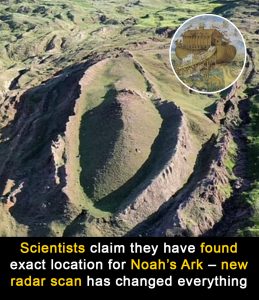Every so often, a scientific claim emerges that grabs the world’s attention and sparks widespread debate. Now, a new revelation is making waves, thanks to an American researcher who believes they may have solved one of history’s greatest biblical mysteries: the possible location of Noah’s Ark. This story has fascinated believers and skeptics alike for generations, and if proven accurate, this discovery could become one of the most significant in both scientific and religious history.

The legend of Noah’s Ark is familiar to millions. According to the biblical account, a massive flood once threatened to destroy every living being on Earth. God instructed Noah to build a gigantic ark that would house his family and pairs of every animal species, saving them from the deluge. The ship is described in the Bible as being enormous—some interpretations suggest it would have stretched the length of half a football field or more. For centuries, the mystery of whether such a vessel existed, and if so, where it ended up, has captivated explorers, archaeologists, and the faithful alike.
Andrew Jones, an independent researcher who has devoted years to investigating the subject, claims he may have found what could be the Ark’s final resting place. Using ground-penetrating radar (GPR), he and his team have identified a site in Eastern Turkey that they believe aligns with the biblical description of the Ark. The location, known as the Durupinar site, lies approximately 18 miles south of Mount Ararat—an area long believed by many to be where Noah’s Ark came to rest after the floodwaters receded.
Jones has made a compelling statement: “It is exactly what you’d expect to find if this were a man-made boat, consistent with the biblical specifications of Noah’s Ark.” His findings are supported by a team of scientific collaborators who are equally dedicated to conducting rigorous research on the site. They’re not interested in promoting myths—they’re focused on empirical evidence and scientific exploration.
The Durupinar site itself is a boat-shaped formation visible from above, measuring around 538 feet in length. Interestingly, that dimension corresponds closely with the biblical measurements given for Noah’s Ark. When the researchers examined the site with GPR, they discovered a 13-foot tunnel-like feature running through the center of the formation. The scans also revealed multiple layers beneath the surface, including what appear to be central and side corridors—structures that mirror the internal layout described in Genesis 6:16, which references “lower, second, and third decks.”
Even more intriguing is the presence of organic material within the site. Jones pointed out that the vegetation growing inside the boat-shaped area is visibly different from that in the surrounding landscape. The grass appears a distinct color, prompting the team to conduct soil tests. These tests revealed lower pH levels and different chemical properties compared to the surrounding soil—an anomaly that could be consistent with the decomposition of wooden material.
William Crabtree, another member of the research team and a soil scientist by profession, elaborated on the significance of these findings. “If you know soil science—as I’m a soil scientist—you’ll understand that potassium levels, organic matter, and pH can all be influenced by decaying organic material,” he explained. “If this was a wooden boat and the wood had rotted over time, we would expect to see elevated levels of potassium, changes in pH, and higher organic content—and that’s exactly what we’re finding.”
Despite the compelling data, Jones is cautious. He emphasizes that what they’ve found isn’t necessarily solid wood or an intact ship beneath the surface. Instead, it could be what he calls a “chemical imprint”—the lingering trace of decayed wood embedded in the earth over thousands of years. “This is not what you’d expect to see if the site were simply a solid block of rock or the result of random mudflow debris,” Jones asserted, adding more weight to the theory that the site could be something of great archaeological importance.
The next logical step for the team is to conduct a drilling survey. According to Jones, this could offer a more precise look beneath the surface, potentially confirming whether the structure is truly man-made or just a natural formation that coincidentally resembles a ship. The drilling process would allow the researchers to analyze deeper layers and possibly uncover physical artifacts or remnants that would solidify their theory.
If confirmed, this discovery could have profound implications. Not only would it lend credibility to one of the most iconic stories in the Bible, but it could also bridge the often-contentious divide between faith and science. The idea that a scientific method could validate an ancient religious account would be groundbreaking for both communities. It could inspire further exploration of other biblical sites, encourage interdisciplinary cooperation, and deepen our understanding of human history.
While many remain skeptical—and rightfully so—the research team isn’t asking people to take their word for it. They are inviting further scrutiny and investigation, hoping that peer-reviewed studies and continued exploration will either validate or challenge their conclusions. Their mission is not to prove or disprove religion, but to follow the evidence wherever it leads.
Ultimately, whether or not this formation in Eastern Turkey turns out to be the remains of Noah’s Ark, the excitement surrounding the discovery serves as a powerful reminder of humanity’s enduring curiosity. Stories like these capture our imagination, stir debates, and push the boundaries of what we think is possible. In a world that often feels divided, this search for answers—rooted in both ancient texts and modern technology—offers a rare and unifying pursuit. So, what do you think? Could this be the site where Noah’s Ark once came to rest? Let us know your thoughts and share your perspective in the comments below.





